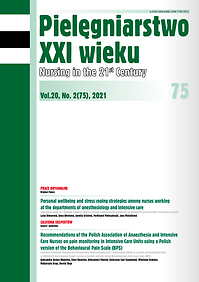Life satisfaction among women after vaginal delivery and caesarian section according to selected socio-demographic characteristics
DOI:
https://doi.org/10.2478/pielxxiw-2021-0011Keywords:
satisfaction with life, labour, vaginal delivery, caesarian section, socio-demographic characteristicsAbstract
LIFE SATISFACTION AMONG WOMEN AFTER VAGINAL DELIVERY AND CAESARIAN SECTION ACCORDING TO SELECTED SOCIO-DEMOGRAPHIC CHARACTERISTICS
Introduction. The multitude of changes taking place in the female body in terms of the physiological aspect as well as in the psychological well-being in the perinatal period has become the motivation to find an answer to the question: what is the women's satisfaction with life (SWL) after childbirth.
Aim. The aim of the study was to analyse the level of SWL among women after vaginal delivery and caesarian section according to selected socio-demographic characteristics.
Material and methods. The study included 128 females after vaginal delivery (n=58) and caesarian section (n=70) hospitalized at the maternity units in Lublin. The study was voluntary and anonymous. It was conducted in 2020 with the use of survey method and utilized two research tools: the Satisfaction With Life Scale (SWLS) and a questionnaire designed by the author in order to collect socio-demographic data.
Results. The mean SWL were 26.12±4.78 in women after vaginal delivery and 24.60±6.17 after cesarean section. Selected socio-demographic factors (age, education, marital status, place of residence, professional status) are significantly related to the satisfaction with life of women after cesarean section; while the material situation and living together with the family among women with vaginal delivery.
Conclusions. Analysis of the results obtained indicated that actions aimed at the improvement of SWL should be directed to young, unemployed, with primary and vocational education, unmarried women and with poor financial situation.
References
1. Shin DC, Johnson DM. Avowed happiness as an overall assessment of the quality of life. Soc Indic Res. 1978; 5(1-4): 475-492.
2. Pavot W, Diener E. Review of the Satisfaction With Life Scale, Psychological Assessment. 1993; 5: 164-171.
3. Basińska MA, Sucharska-Draż A, Wolszczak K. Satysfakcja z życia osób bezdomnych. [w:] Basińska MA. (red.). Osoby bezdomne. Psychologiczne aspekty ich funkcjonowania. Bydgoszcz: Fundacja Salvus; 2014, s. 149-168.
4. Dozier AM, Kitzman HJ, Ingersoll GL, et. al. Development of an instrument to measure patient perception of the quality of nursing care. Res Nurs Health. 2001; 24(6): 506-517.
5. Juczyński Z. Narzędzia pomiaru w promocji i psychologii zdrowia. Warszawa: Pracownia Testów Psychologicznych Polskiego Towarzystwa Psychologicznego. 2001; 134-138.
6. Pavot W, Diener E. Review of the Satisfaction With Life Scale. Assessing Well-Being. 2009; 39: 101-117.
7. Gebuza G, Kaźmierczak M, Mieczkowska E, i wsp. Wsparcie społeczne jako determinant zadowolenia z życia w okresie ciąży i po cięciu cesarskim. Psychiatr. Pol. 2018; 52(3): 585-598.
8. Gebuza G, Kaźmierczak M, Mieczkowska E, i wsp. Life satisfaction and social support received by women in the perinatal period. Adv Clin Exp Med. 2014; 23(4): 611-619.
9. Diener E, Lucas, RE, Oishi, S. Subjective well-being: The science of happiness and life satisfaction. W: Snyder C.R., Lopez SJ. (red.). Handbook of positive psychology. Oxford University Press; 2002, s. 463-473.
10. Kanadys K, Lewicka M, Sulima M, i wsp. Analiza poziomu satysfakcji z życia kobiet w okresie okołomenopauzalnym zależnie od wybranych czynników demograficznych. Medycyna Ogólna i Nauki o Zdrowiu. 2014; 20(1): 42-45.
11. Kaźmierczak M, Gebuza G, Topolińska M, i wsp. Ocena stopnia satysfakcji z życia u kobiet w ciąży. Pielęgniarstwo Polskie. 2018; 1(67): 21-27.
12. Lebrun CE, Schouw van der YT, Jong de FH, et. al. Relations between body composition, functional and hormonal parameters and quality of life in healthy postmenopausal women. Maturitas. 2006; 55(1): 82-92.
13. Marcinek P. Funkcjonowanie intelektualne subiektywna jakość życia osób w wieku emerytalnym. Gerontologia Polska. 2007; 3: 76-81, 85.
14. Jachimowicz V, Kostka T. Satysfakcja z życia starszych kobiet. Ginekologia Praktyczna. 2009; 3: 27-32.
15. Kanadys K, Rogowska J, Lewicka M, i wsp. Satysfakcja z życia kobiet ciężarnych. Medycyna Ogólna i Nauki o Zdrowiu. 2015; 21(1): 45-48.
16. Dennerstein L, Dudley E, Guthrie J, et. al. Life satisfaction, symptoms, and the menopausal transition. Medscape Womens Health. 2000; 5(4): E4.
17. Wysokiński M, Fidecki W, Walas L, i wsp. Satysfakcja z życia polskich pielęgniarek. Probl Piel. 2009; 17(3): 167-172.
18. Skurzak A, Zarajczyk M, Iwanowicz-Palus G, i wsp. Satysfakcja z życia kobiet ciężarnych. Pielęgniarstwo XXI wieku. 2019; 18(4): 207-213.
19. Czarnecka-Iwańczuk M, Stanisławowska-Kubiak M, Wilczak M. Objawy menopauzy, a satysfakcja z życia i samoocena wśród kobiet. Prz Menopaz. 2012; 11(6): 468-473.
20. Machul M, Bieniak M, Chałdaś-Majdańska J, et. al. Lifestyle Practices, Satisfaction with Life and the Level of Perceived Stress of Polish and Foreign Medical Students Studying in Poland. Int. J. Environ. Res. Public Health. 2020; 17: 4445. doi: 10.3390/ ijerph17124445.
Downloads
Published
Issue
Section
License
Copyright (c) 2021 Authors

This work is licensed under a Creative Commons Attribution-NonCommercial-NoDerivatives 4.0 International License.




